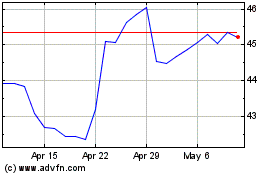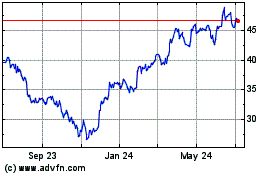By Trefor Moss
This article is being republished as part of our daily
reproduction of WSJ.com articles that also appeared in the U.S.
print edition of The Wall Street Journal (January 15, 2019).
Chinese passenger-vehicle sales fell last year for the first
time since 1990 as economic uncertainty weighed on consumers,
producing a wreck for Ford Motor Co., General Motors Co. and other
manufacturers.
The slump, shown in official data Monday, ended the growth that
many foreign and domestic auto makers had expected to last for
years to come. Facing saturation elsewhere, global auto makers have
banked on China, the world's largest car market.
But a new car is the first thing scrubbed from the shopping list
in uncertain times, said Benjamin Lo, head of China autos research
at Nomura Securities Co. Ltd. China's economy is in a
deeper-than-expected downturn. With the outlook still shaky, he
added, "there's no evidence right now to suggest demand is coming
back."
The expiration of a sales-tax break at the end of 2017
compounded car makers' troubles.
The collapse in sales looks particularly challenging for foreign
makers. GM and Volkswagen AG sell more vehicles in China than
anywhere else, while Ford, Peugeot SA and Hyundai Motor Co. face
acute overcapacity problems.
Chinese auto sales last year reached 28.08 million, down 2.8%
from 2017, the government-backed China Association of Automobile
Manufacturers said Monday. Passenger-car sales fell to 23.71
million, a 4.1% decline, while commercial-vehicle sales rose to
4.37 million, a 5.1% increase.
Electric-car sales surged ahead, increasing 62% to 1.26 million.
The government-enforced shift to electrics may mean that 2017 will
go down as the peak for gasoline-powered cars in China: Over 28
million were sold that year, a total that slipped below 27 million
in 2018 and is likely to be flat or lower this year.
Electric-car sales, accounting for 4% of the 2018 total, seem on
pace to hit the government's 2025 target of 20%, especially with
regulations forcing all auto makers to start producing EVs this
year. Tesla Inc. broke ground on a plant in Shanghai last week and
aims to start production by the end of the year, while GM,
Volkswagen and others are readying a barrage of EV launches.
For the first half of 2018, auto sales seemed likely to continue
their long growth streak: Sales through June were up 6%. But
Jul-December sales were down 11% as the yuan weakened, Chinese
stocks shed value and consumers fretted over China's deepening
trade dispute with the U.S. Another brake on sales came from a
crackdown on unruly online lending -- including peer-to-peer --
which funded a 10th of vehicle purchases in China's smaller
cities.
Worse may lie ahead: Nomura forecasts a 5% sales decline this
year, before the market returns to slow growth in 2020. The auto
manufacturers' association -- which had forecast 3% growth last
year -- anticipates basically flat sales in 2019.
Growth will "be L-shaped in the coming three years," said Xu
Haidong, the association's assistant secretary-general. The
economic downturn and financing squeeze will continue to hurt
spending this year, he said, especially in smaller cities --
denting sales of the lower-end sport-utility vehicles that powered
growth in recent years.
In the small eastern manufacturing center of Danyang, Anji Auto
Sales dealership sells cars from domestic producer Chang'an
Automobile Co. Ltd. Business wasn't pretty in 2018, said sales
director Wan Jun, and a further decline is likely this year: "The
problem lies with a slowing economy, and clients do not have enough
idle money to buy cars as a result."
A cut in the auto-sales tax from 2015 through 2017 postponed the
slump by bringing demand forward, said Ernan Cui, China consumer
analyst at Gavekal Dragonomics.
Beijing, slow to intervene, has begun to signal it might now
that Chinese leaders have put a priority on stabilizing the
economy. A senior official at the National Development and Reform
Commission, which oversees the auto sector, said in an interview
with state media last week that the government is considering ways
to boost demand for cars.
Ford had a particularly disastrous year in China, with sales
falling 37% to 752,243 -- the lowest since 2012 -- following a 6%
decline in 2017. Its December sales were down 59%. "We start 2019
with a new mind-set," Ford's China head Chen Anning said in a
statement, promising 10 new products this year.
GM's China sales last year came to 3.65 million cars, down 10%
-- including a 25% drop in the fourth quarter.
Foreign auto makers are scrambling to adjust to the tastes of a
more selective Chinese consumer just as domestic rivals are
becoming more adept. Indeed, the strongest Chinese brands increased
their sales last year. Zhejiang Geely Holding Group Co.'s sales
were up 20%, breaking 1.5 million, despite a fourth-quarter stall.
After 46 consecutive months of growth, sales of the company's main
Geely brand were down 10% in both October and November and 45% in
December, causing the Hangzhou-based company to miss a yearly sales
target of 1.58 million.
Volkswagen said that sales of its VW brand -- long the best
seller in China -- declined 2% to 3.11 million in 2018. Despite the
troubling outlook, the company will double down on China by
investing more locally and tailoring new models to Chinese tastes,
Chief Executive Herbert Diess told reporters in Beijing last week:
"The future of Volkswagen will be decided in the Chinese
market."
The premium segment was immune to the chill. Sales of Cadillac
-- the only GM brand to grow in China last year -- were up 17%,
while sales of Mercedes-Benz cars made by Daimler AG and VW-owned
Audi AG both increased 11%.
Shan Li and Lin Zhu in Beijing contributed to this article.
Write to Trefor Moss at Trefor.Moss@wsj.com
(END) Dow Jones Newswires
January 15, 2019 02:47 ET (07:47 GMT)
Copyright (c) 2019 Dow Jones & Company, Inc.
General Motors (NYSE:GM)
Historical Stock Chart
From Aug 2024 to Sep 2024

General Motors (NYSE:GM)
Historical Stock Chart
From Sep 2023 to Sep 2024
